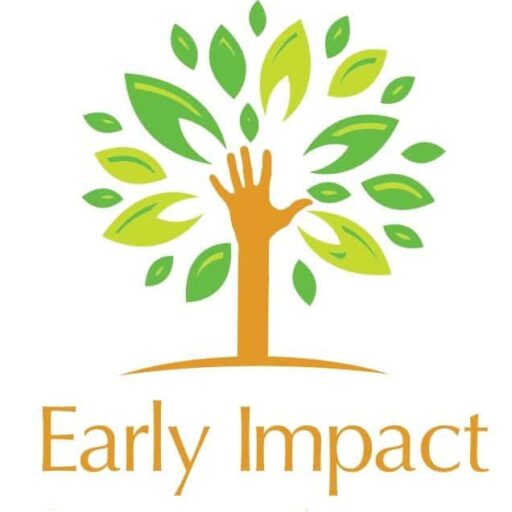1 to 1 correspondence is super important! In the ten years I have taught young children between the ages of 3 and 5, I have found that 1:1 correspondence is a foundation for all the skills that come after it: adding, subtracting, finding one more and less, and lots of other things, too.
Without one to one correspondence, all these are a non-starter.
This article is just as much for parents as teachers. There is a lot of jargon around the teaching of maths, and terms like ‘1 to 1 correspondence’ can seem quite intimidating. However, it is a simple skill to understand and get your head around, and a fun one to teach, too. (I promise!)
Firstly, put simply, what is 1 to 1 correspondence?
1 to 1 correspondence is the skill of counting one object as you say one number. For example, if you are counting objects, you point at the first item and say ‘1,’ then point to the second and say ‘2’ and so on.
Sounds simple! However, it takes pretty much all children a huge amount of time to get really secure with this skill.
Like all the best skills it takes time, practice and a few strategies to really hammer the message home.
Also, there are numerous pitfalls and problems you might encounter on the way.
This article will hopefully give you all the knowledge you need to meet these issues head on! How do you introduce it? How do you practice it? At what age should children start doing it? What problems will you encounter?
Find out the answer to all these things, and more!
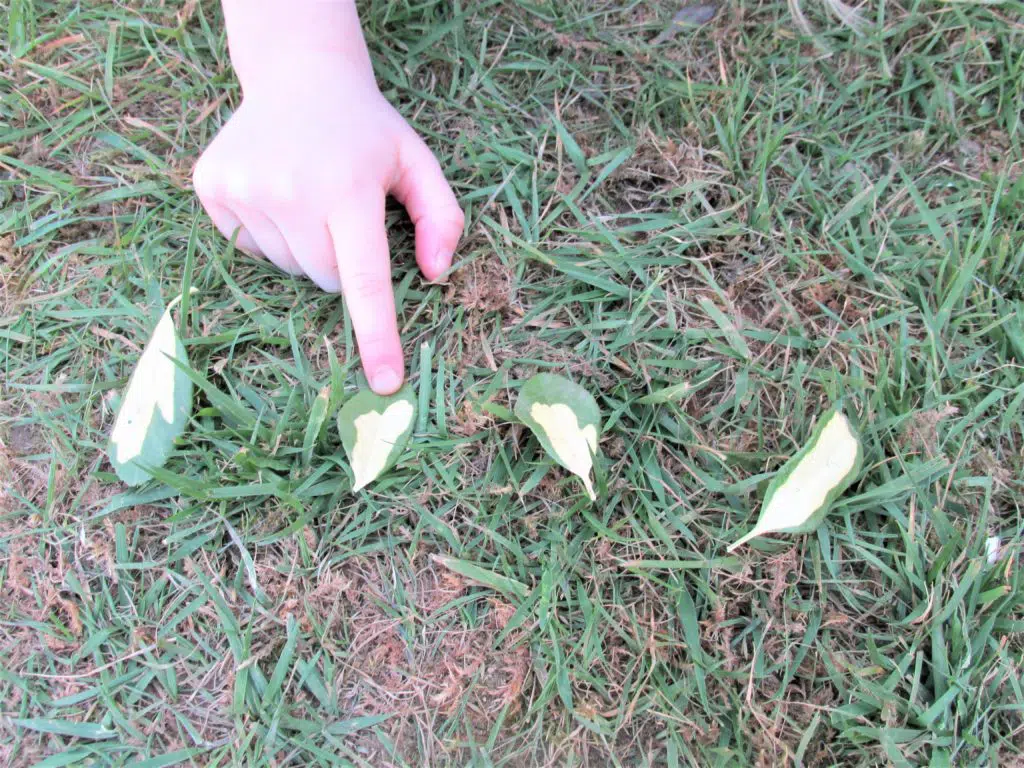
One To One Correspondence
1 to 1 correspondence is basically counting accurately! It is understanding that one number in a sequence goes with each thing that you are counting. Each is worth the same – one!
You use 1 to 1 correspondence whenever you count a quantity of something. This could be:
Counting Stationary Objects
This could be counting shells or stones, for example. Or you might be counting the characters on a page of a book, or the number of toys in a counting song like 5 Little Ducks. Some stationary objects you can move yourself (like a stone), but some you can’t (like a house)
Counting Moving Objects
Examples of this could be things in the sky like birds or clouds. Or it could be things on land like animals, cars, or other children.
Counting Actions
This could be things like how many jumps. Or how many hops, claps, kicks, or skips.
Counting Sounds
This often takes them a bit longer to get their heads round as they can’t see the things. Examples of this are things like counting the firework bangs, or the hits on a drum or tambourine.
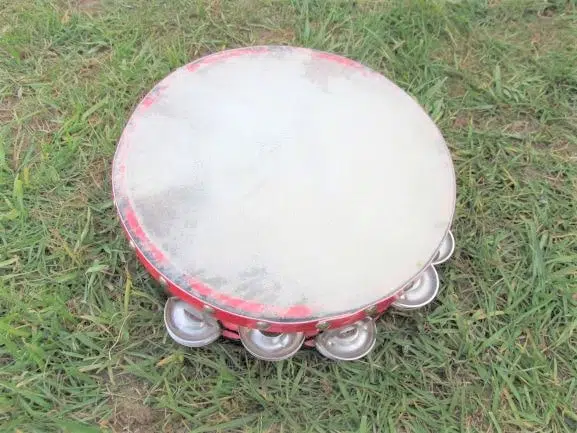
So, there are many different types of opportunities for 1 to 1 correspondence. But what skills come before 1:1 skills can take place? Let’s look at that first…
What Comes Before 1 to 1 Correspondence?
The big skill that children need before they can effectively attempt 1 to 1 correspondence, is the ability to rote count.
Rote counting is quite simply saying numbers in order, usually starting with 1. You don’t have to count any objects, or anything like that. It is just saying, ‘1,2,3,4…etc’
If you want to get the full lowdown on what rote counting is then check this out.
Rote counting is something many children will begin to develop from quite a young age if they are exposed to enough fun counting opportunities.
Some great ways of getting children trying to rote count include:
Counting Stairs
This is the absolute old classic activity! Even when you are carrying babies up or down stairs, there is no reason not to count the stairs as you go!
This will become a ritual later on, and children will be joining in the counting whenever they are able.
Count For Fun!
Young children just find it quite fascinating counting without any reason! So when you are getting them dressed, or having breakfast, just counting to them can be surprising fun and interesting!
Children like things repeating, and knowing what’s about to happen, and counting definitely fulfils this.
Count Food
Take time to count out fish fingers onto the their plate – ‘1,2,3!’ Or strawberries, or whatever else you have. Simple, but good and something that you can repeat often and make a routine.
If you want to find out a full range of many activities that develop rote counting, then you are in luck! I have written a detailed article about this which you can check out here.
How To Start With 1 To 1 Correspondence
When children can count to probably at least 5 by rote, then they are ready to start practising 1 to 1 correspondence. Please remember, this will not happen over night! It is more of a process than an event.
There are some excellent simple things you can do regularly that get them going.
1. Count Things In Books
Most children enjoy using books as a ‘hook’ into learning. They really focus their full attention.
Books are great for all sorts of counting opportunities, including:
- Counting characters on a page
- Counting objects
- Read counting song books (of which there are many), and count the objects on each page
- Read specific counting books and count the objects

2. Count Actions
Count anything that happens, like someone is jumping. Someone is hitting a tambourine. When it happens, count it!
3. Count Objects In Play
Linking numbers to the real world is crucial. Whenever you can model counting objects in their play, then do it. The more this is introduced, the stronger children will see that counting links to reality. They will hopefully start doing it themselves at some point.
If they do, this is massive! The desire to count really speeds along the process of developing solid accurate counting.
4. Count Things In The World Around Us
There are quantities everywhere we go. In particular you can count things like:
- Trees
- Flowers
- Clouds
- Birds
- Cars
- Trains
- Plates
The world is your oyster! Whatever children come into contact with, help them count it.
Introducing 1 to 1 – The Process
Whenever you try out any of the four strategies I’ve just outlined, there is a process to through which looks a bit like this:
Step 1– It basically starts with the adult showing how to count.
Step 2 – Then you move onto a phase where the adult counts, with the child helping.
Step 3 – The child begins to count, or you ask them to count things. The adult helps when required
Step 4 – The child counts independently by themselves.
These steps can take many months, even years. But this is basically the process to go through.
Some Top Strategies For 1 To 1 Correspondence
As children get more and more exposed to counting for a purpose, there are some definite strategies that you can model and teach them to help them improve.
Some of the best include:
1. Teach Them To Point
Sounds obvious! But of course it’s not unless you show them.
Pointing is a massive part of accurate counting. It provides a visual structure to help them break up the sequence of numbers. It also makes the experience multisensory, which really helps access their full attention.
Model pointing at one object, saying a number, and moving on to the next object. Certainly not rocket science, but crucial nonetheless.
2. Count Slowly
This is another thing that is really important.
Often children go wrong because they are trying to go too quick! This is understandable, because they have probably learned to rote count at that speed, but it is then impossible to move their finger accurately and count all at the same time.
Model slow and steady!
3. Move Objects Into A Line
This is a good trick if there are several objects in a random array.
It is far easier for children to put them in a line, at least when they start out. Put them in a line, and then slowly count from one end of the line to the other.
1 To 1 Correspondence For Different Arrays
1 to 1 correspondence is not as simple as just counting a few objects in a line.
In the world, physical objects will come in many different types of array. This is particularly true in play, when objects will be all over the place!
There is a different practical skill required in counting each of these different arrays. Let’s take a look at the most common arrays and how to count them:
Straight Lines
This is the easiest way of counting objects. You will often find straight lines of objects in play, and also in the world – such as a line of trees, or a street of houses. Count from left to right.

Random Assortments
These are the most popular type of array in play. Some examples might be building blocks on the floor, apples in a bowl, or shells on a dish.
To start with, many children find it easier if they first put them in a line and then count.
You can also pick one up, say the number, move it, and then pick up the next and say the number.
More skilful children can later use a system. There is no cut-and-dried way of counting a random assortment of objects. Some children will go roughly from left to right. Some might go top from bottom. As long as there is some system, they are more likely to get it correct (or roughly correct. The odd mistake is completely normal)
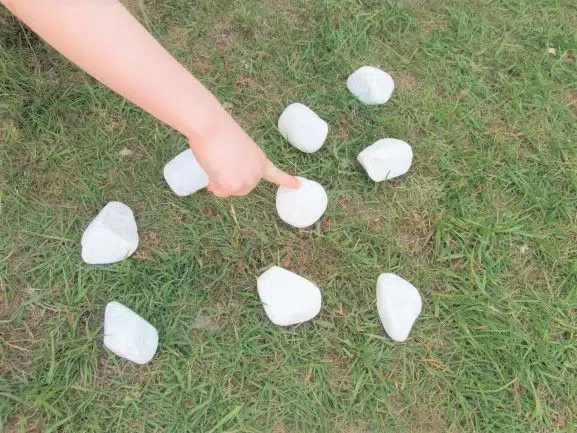
Circle
Counting arrays in a circle is more unusual. The big problem with this is counting round the circle and not remembering to stop (and just carrying on counting again).
The big thing with this is make a clear decision where to start and try to remember this.
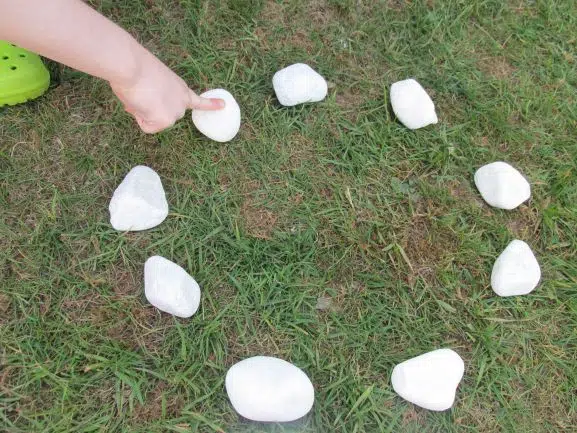
9 Games To Support 1 To 1 Correspondence
Now you know all the theory about what it is, let’s check out some of the best ways of teaching 1 to 1 correspondence.
1. Whack The Dough
This is a great active counting game. What you need for this is some playdough and a dice. Playdough is one of the greatest maths resources, and there are so many brilliant games you can do with it.
Get the children to make lots of small balls of playdough – probably at least 20 or even 30 balls.
Then get one of them to roll the dice.
The idea is that whatever number you get, you all whack that quantity of balls of dough. So, for example, if you roll a 4 you all whack 4 balls – 1,2,3,4!
This can be extended by using things to whack them with, for example a fly swatter! Or a mini mallet with goggles on. A really visual game, that really gets it into your head that it is one action for one number.
2. Dice Games
All you need for this is one dice. It could be either a numeral or a dots dice.
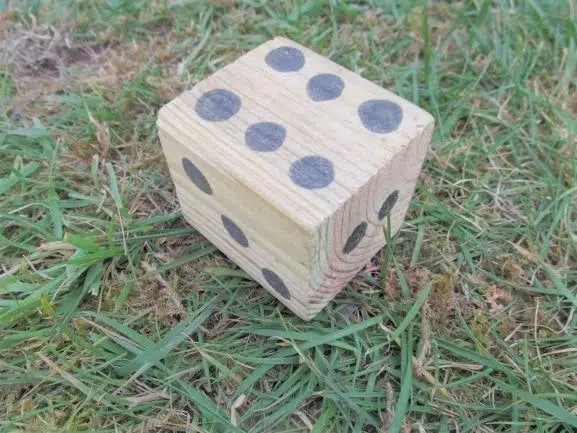
One game, is that you pick an action, for example jumping. Roll the dice, and then everyone does that number of jumps!
Some good actions to do include hopping, skipping, clapping, roaring (!), or star jumps.
This is one of many brilliant maths circle time games that I write about in this article.
3. Count Marching/Dancing
Put some pumping disco tune on for this game!
The basic idea is that you do some kind of dance move or action to the music and start to count!
Once again you could roll a dice for this. For example, if you roll a six you can do six arm pumps in the air!
An extension of this is doing a simple dance routine. It could be something like ‘4 stretches to the left, 4 to the right, 4 to the top, 4 down low.’
Roll the dice, pick a different number, and do the routine to the music again but with a different quantity of actions.
4. Counting Songs With Objects
Counting songs are one of the best ways of teaching a range of maths skills, including calculating and counting.
All you need is some objects or pictures to go with the song. It could be 5 Cheeky Monkeys for example, or 5 Little Ducks.
All count the toys, and then sing the song. Take one away, and count again. Great for getting their full attention, because the activity is so multisensory.
5. Objects Linked To Books
There are many books you can read that you can link to some simple objects that go with the book.
For example, if you have three toy goats, you can read ‘The Three Billy Goats Gruff.’
Move the toys around depending on the different parts of the story, and count how many you have at any one time.
6. Count The Instrument Hits
This is a great way of practising counting sounds, which is quite a tricky skill.
Get an instrument, such as a drum, and hit it a certain number of times. The children count the hits and say what they think. More skilful children can write the answer on whiteboards, or show it on number fans.
7. 1:1 Counting Stones
These stones are a beautiful natural resource. They are simple to make and will last a lifetime. They are brilliant either used inside or out (check out 50 brilliant outdoor math ideas here.)
I just bought some white sparkly stones, and painted them with acrylic paint:
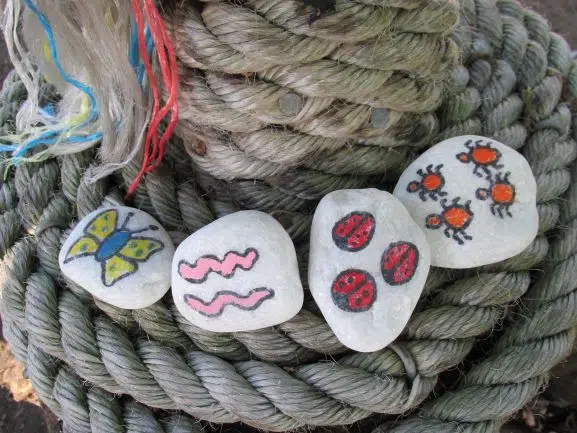
I painted different quantities of bugs on them. They are great for simple counting.
Also, they are excellent for storytelling and mark-making. Children can make up stories such as ‘One day, two worms went on an adventure. They met 5 snails.’ Stories are another way to get children’s full focus.
8. Puzzles – Like Padlocks
An element of drama or story is great for interesting them.
You could, for example, tie up a superhero with padlocks! The locks would have dots on, and there would be a set of keys with numbers on to go with them. Count the dots and then use the correct key to open the padlock and free the superhero!
9. Skittles Or Knocking Down Cups
Active games such as skittle or knocking down cups are brilliant for counting.
For the cups game, just get a few plastic cups and get the children to try to stack them. Then they try to knock the tower down with a beanbag, and count how many cups fall over.
Any kind of skittles or pins game is great too, and can be extended into a number bonds activity.
For example, if you have five pins and two are knocked over how many do you have left? It’s always a number bond, and children could potentially record the bonds they find.
Top Tips For 1 To 1 Correspondence
- It is a long process so be patient!
- Link counting to reality as much as possible
- Make it multisensory – use songs and chants and movements
- Model as much as possible
- Teach them strategies like pointing, and taking it slowly
Conclusion
1 to 1 correspondence is a really long process, but once children have mastered it, a whole world of possibilities then awaits.
Make it as fun and active as you can, and the majority of children will get the idea with practice.
READ MORE
